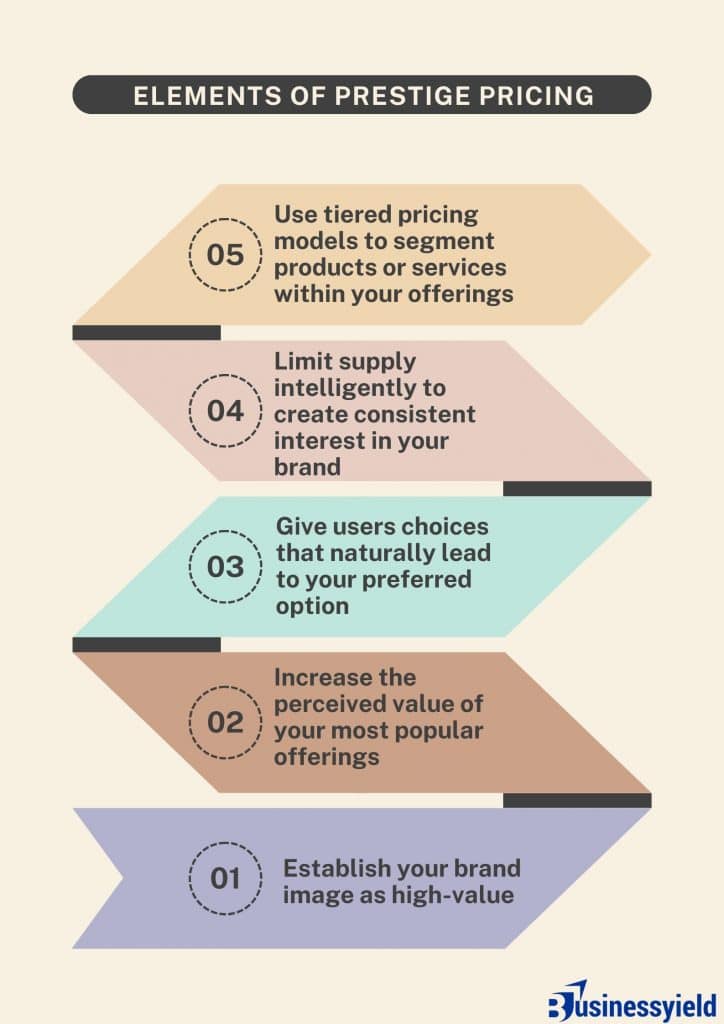Recently, I was in the market for a new pair of sneakers, and I came across several that caught my eye. Of course, I couldn’t buy all of them, since I only needed one, which meant my choice came down to price and quality. And, as expected, I automatically presumed that the higher-priced sneakers had to be of correspondingly higher quality. That is the premise of prestige pricing.
If you want to increase the profit margin of your e-commerce business, charging higher prices is one of the most efficient solutions. People often equate higher costs with higher quality. The two concepts seem naturally linked. The natural inclination to believe, “Well, that company must be charging that much for that product for a reason,” that mentality that often leads us to believe expensive means better, is the basis for prestige pricing.
You might find a cheap price alluring if you have a limited budget or you happen to be a corporate buyer, yet someone with a high social status or certain quality requirements is ready to pay extra. As a business owner, you must be able to capitalize on this to either set your brand apart from your competitors or provide premium products and services that do so.
Key takeaways
- Prestige pricing, usually referred to as premium pricing, is a strategy that aims at selling expensive products to higher market segments.
- Prestige pricing is a tactic businesses leverage to shape premium brand perception by charging premium prices.
- Companies should offer genuinely high-quality products, or at least products that are regarded as top-notch, for this strategy to be effective.
- Prestige pricing also requires more marketing expenses than sales of regular goods, because the company needs to build a brand image that creates a premium perception in consumers’ minds.
- The approach will fall short if people don’t see any value in an overpriced item.
What is prestige pricing?
Prestige pricing — also known as image pricing or premium pricing — involves using high prices to suggest a high-quality product or service. It operates on the principle that price is one of the main drivers customers use to determine a product’s value.
According to this theory, customers perceive a more expensive product as higher quality and a lower-priced product as less so. You can use prestige pricing to target customers eager for a premium product, like habitual luxury shoppers, or people motivated to splurge on high-end goods under certain circumstances, such as for a gift or to celebrate a special occasion.
A prestige pricing strategy is often closely tied to brand perception. Companies that take this approach often have products that are recognized for their superior quality or the value they add to the lives of customers. The pricing method is based on the assumption that consumers perceive more value at higher prices — that expensive products are priced that way for a valid reason. Prestige pricing strategies can vary depending on a company’s goals for its brand and offerings.
If you want to implement one yourself, you’ll want to look at competitors in your market to see how they price products that are similar to yours. With a unique value proposition that differentiates your product from the competition, you’ll be able to justify a higher price point.
I have compiled the following articles for you to learn more about setting the right price for your products and services:
- PRICING STRATEGIES MARKETING: Definition, Types & How to Choose
- Pricing Analysis Techniques: Detailed Guide to Price Analysis
- What Is Pricing? Understanding Pricing In The Marketing Mix
You can also check out the video below for more insights:
How prestige pricing strategy works
A premium pricing strategy is based on the assumption that certain consumers will pay extra for a product’s image, but won’t further research the value of the product relative to the price they are paying. Therefore, this tactic might provide your business with a psychological marketing benefit, since it will make buyers believe that the price they are paying is worth the increased value.
Elements of prestige pricing
Simply raising your prices won’t do the trick. Just because something is more expensive doesn’t mean it has more value or provides greater benefit to buyers. To make prestige pricing effective, you need an approach that underpins the value of prospective offerings in a way that resonates with customers and aligns with their subconscious perception of what a prestige product should deliver.
But what does this look like in practice? Let’s break down the key elements of a prestige pricing strategy.

Establish your image
If you want to charge prestige prices, you need to establish a brand image that sets you apart from the competition and positions you as the highest-value option in the market.
I have a friend who is into the clothing business. On a surface level, MAD Habit doesn’t look like it is much different from the average clothing store, but it has managed to establish itself as a quality clothier of customizable outfits that cater to individual choices. This allows the brand to charge substantially more than its nearest competitors, even though many similar brands have features that are nearly on par with MAD Habit.
The difference? Image. MAD Habit has spent the time and money to create an image across its website, social media platforms, and sales channels. This has helped position its products as tasteful and customizable for those who want the best of the best — and are willing to pay for it.
The same strategy applies to building your brand if you want to charge prestige pricing. First, you need to find a niche: Which set of products or services are your focus? Next, you need to establish a set of target customers and create a consistent brand image and experience across all of your channels. Finally, you have to deliver a product that lives up to initial expectations and that gets people talking about your brand, in turn reinforcing your image.
READ: Why Image Enhancement Matters for Your Business and Branding: Leveraging AI Technology
Increase perceived value
Next, you need to increase the perceived value of your most popular offerings with the creation of targeted pricing strategies.
Consider psychological pricing, which leverages consumers’ perceptions of a product’s value based on its price. The number nine offers the most obvious example: products priced at $39 instead of $40 or $9.99 instead of $10 are often perceived as both more affordable and of slightly lower quality, even though there is practically no difference.
If you’re looking to create the impression of a premium product, you should opt for round numbers. While this limits your potential buyer pool, it unconsciously creates a sense of greater value among customers and helps set your brand apart from the competition.
Make the most of choice
User choice is critical in establishing a premium brand — if you can make it work in your favor.
Here, the goal is to give users a set of choices that naturally lead to your preferred option. This concept is sometimes called the “Magicians Choice”, in which audience participants are given choices that always lead to the same outcome.
For example, if you have three objects (A, B, and C) and want someone to pick A, you ask them to select two objects. Suppose they pick B and C, you say you’ve eliminated them and A is the choice. If they pick A and B, you eliminate C and ask them to choose again. If they select B, you eliminate that and select A. And if they select A, you’ve achieved the goal.
You can apply a similar choice strategy to prestige pricing. By offering a variety of price points for different product categories, you can naturally shift buyers toward your highest revenue generators and also capture top-tier customers.
Consider a product page with four categories. Each category is progressively more expensive — let’s say $50, $100, $250, and $500 — and each category comes with additional features. Suppose your ideal revenue generator is the $250 category. In that case, you ensure that this offering has the most included features for the price, making it a substantive improvement over both lower-priced categories and therefore a better deal from the consumer perspective.
The $500 category, meanwhile, only offers a few additional features and isn’t designed to represent your biggest sales volume. Instead, this top-tier prestige pricing will capture a few customers at the highest end of your market to drive an improved reputation.
Intelligently limit supply
Limiting supply is also a key component of an effective prestige pricing strategy. At first glance, it makes more sense to have your product available to everyone who wants it and can afford it, but this short-term revenue is often outpaced by the long-term benefits of generating excitement for products that aren’t widely available.
By intelligently constraining supply to drive up demand, you can also increase prices and create more consistent interest in your brand. The caveat? Don’t take it too far—if no one can get their hands on your product, you’ll start losing customers to the competition.
Use tiered pricing models
You can also use tiered pricing models to differentiate products or services within your offerings to create a higher-priced option for customers seeking a premium product. Tiered pricing models can highlight the differences between premium and standard product offerings and showcase the additional features offered for the higher price.
For example, if your company sells smart pet beds, you might offer the following product tiers:
- Standard
- Built-in heating
- Timed on/off
- Chew-resistant
- Made from organic and non-toxic materials
- Premium
- All standard features, plus:
- Cooling
- Automatic on/off and nap detection
- Premium plus
- Standard and premium features, plus:
- Antimicrobial coating
- Bluetooth connection
- Built-in massage features
- Aromatherapy portal
Prestige pricing techniques
You can implement prestige pricing in different ways (separately or by combining them). Below are three techniques that are widely used in e-commerce and other industries:
- Psychological pricing. This method of pricing entails choosing a price that consumers will unavoidably identify with a high-end item. Prices that end in the number nine, for instance, $7.99, give the sense that you’re offering a bargain, while prices that end in zero imply luxury.
- High-end marketing. Associations with other high-end businesses or endorsements from celebrities who are regarded as being in the upper class themselves can make people think of your business as belonging to the premium segment.
- Supply controls. Even though it may seem contradictory, limiting the market’s supply of your goods might eventually increase sales. The sale of limited-edition goods at a premium is a great example of prestige pricing. When combined with a top-tier brand image, these offers create the appearance of scarcity, which can heighten interest anytime you reveal a new product.
Well-known clothing and fashion labels often use this to create hype around each limited-edition collection of goods.
Below is a checklist I have compiled for you to follow to implement prestige pricing strategies in your business today and increase your profit margins:
BusinessYield Prestige Pricing Strategies
Advantages of prestige pricing
Prestige pricing can help you communicate exclusivity, boost demand for a product, and increase profit margins. Here’s an overview of the benefits:
Increased revenue
Prestige pricing doesn’t increase the costs of producing products, but implementing prestige pricing strategies can increase revenue and profit margins. For example, imagine that you produce a hot cocoa mix that costs you $1.76 per unit. Under a standard pricing strategy, you might charge $2.99 per unit. This is enough to offset your costs and provide you with a profit on each sale.
Under a prestige pricing strategy — assuming you can convey your product’s superior qualities — you might charge $6 per unit. With this, you can increase your profit and revenue on each transaction without increasing your market share.
More demand
Prestige pricing strategies can also increase demand for a product. This is particularly true if you limit product supply to suggest exclusivity.
For example, you might release a limited edition handbag with the expectation that it won’t fulfill the demand for the product. Not every consumer who wants a handbag will be able to obtain one, and this scarcity can confirm consumer assumptions that the handbag is appropriately priced. Your company may be able to maintain (or even increase) prices on future product launches and increase production volume.
SEE: LAW OF DEMAND: What Is It & How Does it Work
Improved brand perception
The baseline assumption of a prestige pricing strategy is that potential customers use price to determine value, which means that increasing prices can lead customers to assume that products are higher quality—boosting your brand image and creating a perception of greater brand value.
Disadvantages of prestige pricing
Although prestige products typically don’t cost more to make, a prestige pricing strategy can increase your marketing costs. In addition, a failure to invest in luxury product marketing or align a new strategy with market needs can make your strategy backfire.
Here are three potential disadvantages of prestige pricing:
Decreased sales volumes
In some cases, adopting a prestige pricing strategy can hurt sales. Although you earn more money on each sale, charging more can restrict the size of your target audience.
Conduct target market research to understand how a higher price point might affect your sales volume. This might require calculating whether increasing your profit per transaction can offset the potential loss of customers.
Higher marketing costs
Although raising prices can imply increased product value, this strategy involves marketing investments to support an elevated brand image and justify the higher prices. Creating prestige marketing materials can be expensive, and you might also need to invest in upscale packaging and sales infrastructure to communicate consistently that you offer a high-value product or service.
Damage to brand image
Boosting prices can improve your brand image — but it can also damage your image. Your prestige pricing strategy can backfire if your customers decide that your prices aren’t associated with actual product value.
Examples of prestige pricing
You can apply prestige pricing to almost every industry that provides goods and services to customers. Here are the most common examples:
- Cars. The automobile industry also features a few top-tier brands with premium pricing, for example, Lexus, Mercedes, Porsche, and Lamborghini.
- Premium jewelry. The diamond industry is characterized by prestige pricing, since not many people can afford diamonds, and expensive jewelry highlights their financial status and wealth. Cartier and Tiffany are good cases in point.
- Airlines. The majority of airlines offer business-class tickets with a booking price that’s 200-300% of regular tickets. These are intended for people who need top-tier services and maximum comfort during flights.
- Watches. There are hundreds of watch brands on the market, but high-class customers still prefer Rolex despite their high price. Not only do Rolex watches ensure exceptional quality, but also exhibit buyers’ financial wealth.
Prestige pricing: The price of perception
In prestige pricing, the price of the product is part of the marketing strategy. The point of this tactic isn’t the functionality of the product but it’s the image associated with owning a high-end product. Prestige pricing also conveys a level of confidence to the consumer, as the company believes in its product quality so much that it can charge a much higher price for it.
Perception matters. If you can establish yourself as a premier option in your market vertical, you can charge a higher rate for goods and services, even if these prices don’t reflect the actual value of the goods in question.
Simply put, prestige pricing remains viable thanks to one of the core tenets of economics: A product is worth whatever people are willing to pay for it.






